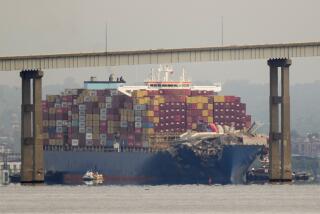Ship Deaths Laid to Inadequacies of Survival Gear
- Share via
WASHINGTON — Federal investigators said Wednesday that the improper stowing of life vests and malfunctioning emergency rafts contributed to the loss of life when the sailing ship Pride of Baltimore sank in the Atlantic Ocean.
The National Transportation Safety Board, ending its investigation into the May 14, 1986, accident 250 miles north of Puerto Rico, said also that the design of the ship contributed to the flooding of the vessel after it encountered a strong wind and tipped over.
Four crew members died when the ship, a reproduction of an 1812 Baltimore clipper, sank. Eight other people were rescued after drifting for five days.
‘Rafts Malfunctioned’
The safety board said contributing factors to the loss of life were the “inability of the crew to retrieve life preservers from their stowage below deck and the malfunction of the vessel’s life rafts.”
It added that the sinking was the result of “a sudden onset of a high velocity wind that exceeded the limits of the vessel’s stability,” causing it to tip over and flood.
The board said that the extensive and rapid flooding was caused by a “lack of watertight bulkheads in the hull.”
More to Read
Sign up for Essential California
The most important California stories and recommendations in your inbox every morning.
You may occasionally receive promotional content from the Los Angeles Times.










